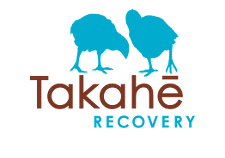Takahē release, Murchison Mountains, Lake Te Anau
Image:
OneShot / Robert Brown
| ©
How we're helping takahē
Introduction
The Takahē Recovery Programme involves a network of people around Aotearoa New Zealand, working together to ensure the takahē is never again considered extinct.
Our vision and goals
Takahē Recovery Programme vision
Takahē exist in growing numbers in large areas of their former natural range as a functioning element of natural ecosystems, and are treasured as a national icon.
Our goals: A plan for the future
Four goals guide the conservation of takahē. Our goals to be achieved by 2026 are:
- Takahē population growth rate is greater than 5% per year.
- Increase the takahē population to at least 60 breeding aged pairs at secure sites.
- Maintain the Murchison Mountains and establish at least one new recovery site.
- Takahē are recognised as a:
- taonga (treasure)
- a conservation icon
- unique and well-known conservation story.
Our work
The work of our small, dedicated team includes:
- an intensive breeding programme
- managing genetics by moving takahē around New Zealand
- research and monitoring
- returning takahē to safe, wild sites
- advocacy and education.
Read more about our work and who is supporting us below.

